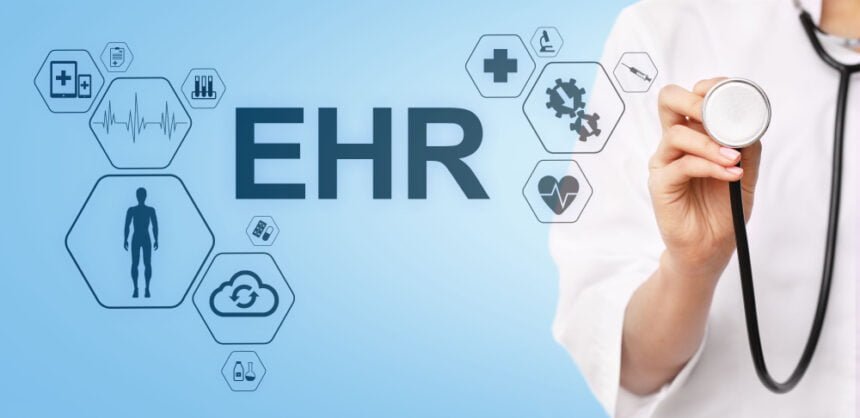The perpetuation of the electronic health record (EHR) marks a significant advance in delivering ultramodern- day medical care. EHR’s modern stores of patient clinical data can demystify patient thinking, streamline work processes, and upgrade clinical independence. The electronic health record (EHR) briefly describes the various actions. Effective on boarding necessitates a comprehensive strategy considering scale status, end-to-end work processes, customer readiness, information security, and specific styles.
According to the gitnux.com EHR (Electronic Health Record) market, full of opportunities, it had a staggering amount in the range of $26.8 billion in 2020. But that’s not all, and people are anticipating that the market in this area will grow, expand and perhaps even explode, averaging an incredible $38.3 billion in 2026.
As medical care providers move to traditional paper-based electronic processes, understanding the importance of EHR implementation becomes principal. With an emphasis on streamlining problems and clinical care operations, this composition offers guests and styles for a seamless and effective transition to an EHR electronic health record.
The Importance of EHR Implementation:
Electronic health records (EHR) have emerged as the foundation of current medical services, significantly affecting patient perception, clinical navigation, and functional skills. Electronic Health Records EHR empowers clinical consideration suppliers to make more intensive judgments of a patient’s disease, work with quicker analysis, modify treatment plans, and experience fewer clinical mistakes by digitizing and incorporating clinical data.
The ceaseless dissemination of information between various clinical benefit substances further develops care coordination, which deals with steady outcomes. EHR supports proof-based works, enabling clinicians to acquire legitimate data and tests for extra-instructed clinical mediation. In past medical benefits, EHR streamlined documentation processes reduced administrative work, and limited duplication of effort.
As medical services embrace computerized change, EHR is an exceptional device enabling providers and laying the foundation for a more connected, specialized, patient-centered medical care ecosystem.
Steps for Successful EHR Implementation
1. Needs Assessment and Planning
Start the EHR implementation journey by conducting an in-depth review of your organization’s needs, existing workflows, and any pain points an EHR system could address. Develop a detailed implementation plan outlining goals, objectives, and expected outcomes.
2. Select an EHR Vendor
To find an EHR vendor whose system fits your organization’s needs, consider user-friendliness, scalability, customer support, and integration capabilities as crucial deciding factors. Thoroughly investigate their track record, security measures, and compliance with industry standards before making your choice.
3. Customization and Training
Personalize the EHR system to fit seamlessly with your organization’s workflows and processes to minimize disruption to current operations. To optimize system usage, provide thorough training to all users, from medical staff to administrative personnel.
4. Data Migration and Integration
Transfer existing patient data securely and accurately into an EHR system, and ensure seamless integration with other methods used within your organization – such as billing, scheduling, and laboratory systems – which increases efficiency while decreasing data entry redundancies.
5. Bench Testing and Quality Assurance (QCA)
Before fully deploying an EHR system, rigorously test it in a controlled environment to identify and address any technical glitches, usability issues, or data integrity concerns. Rigorous testing helps minimize disruption during the transition phase.
6. Rollout Gradual and Feedback Loop
Implement your EHR system gradually across various departments or units to successfully address any unexpected obstacles, gather user feedback on any concerns, and make necessary adjustments – taking an iterative approach will guarantee a more seamless transition.
7. Ongoing Training and Assistance
Implement ongoing training sessions and robust user support for your staff as they adjust to a new system. Address all queries, concerns, or technical issues promptly to maintain an enjoyable user experience and prevent frustrations.
8. Data Security and Compliance
Prioritize data security by adopting comprehensive security measures such as encryption, access controls, and audits to safeguard patient privacy and build trust. Comply with healthcare regulations like HIPAA to protect patient confidentiality while upholding the conviction.
9. Monitoring and Optimizing
Continuously track and assess your EHR system’s performance, user adoption rates, and workflow impact. Look out for optimization or upgrade opportunities so your system meets your organization’s changing needs.
Conclusion
Electronic Health Records mark an unprecedented shift in healthcare delivery, streamlining patient care while improving clinical operations. Their rapid rise in the market illustrates their significance as healthcare providers increasingly recognize their value.
By taking a systematic approach and considering factors like needs assessment, vendor selection, training integration support, and ongoing support services, organizations can transition smoothly into EHR systems and position themselves at the forefront of modern healthcare provision – becoming more patient-centric by contributing toward an ecosystem.

